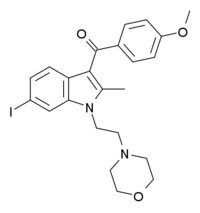AM-630
 | |
| Legal status | |
|---|---|
| Legal status |
|
| Identifiers | |
| |
| CAS Number | |
| PubChem CID | |
| IUPHAR/BPS | |
| ChemSpider | |
| ChEMBL | |
| ECHA InfoCard |
100.229.964 |
| Chemical and physical data | |
| Formula | C23H25IN2O3 |
| Molar mass | 504.360 g/mol |
| 3D model (JSmol) | |
| |
| |
| | |
AM-630 (6-Iodopravadoline) is a drug that acts as a potent and selective inverse agonist for the cannabinoid receptor CB2, with a Ki of 32.1 nM at CB2 and 165x selectivity over CB1, at which it acted as a weak partial agonist.[1][2] It is used in the study of CB2 mediated responses and has been used to investigate the possible role of CB2 receptors in the brain.[3][4] AM-630 is significant as one of the first indole derived cannabinoid ligands substituted on the 6-position of the indole ring, a position that has subsequently been found to be important in determining affinity and efficacy at both the CB1 and CB2 receptors, and has led to the development of a large number of related derivatives.[5][6][7][8][9]
See also
- WIN 48,098 (Pravadoline)
- WIN 54,461 (6-Bromopravadoline)
- AM-1221
References
- ↑ Ross RA; et al. (February 1999). "Agonist-inverse agonist characterization at CB1 and CB2 cannabinoid receptors of L759633, L759656, and AM630". British Journal of Pharmacology. 126 (3): 665–72. doi:10.1038/sj.bjp.0702351. PMC 1565857. PMID 10188977.
- ↑ Murataeva, N.; MacKie, K.; Straiker, A. (2012). "The CB2-preferring agonist JWH015 also potently and efficaciously activates CB1 in autaptic hippocampal neurons". Pharmacological Research. 66 (5): 437–42. doi:10.1016/j.phrs.2012.08.002. PMC 3601544. PMID 22921769.
- ↑ Morgan NH, Stanford IM, Woodhall GL (September 2009). "Functional CB2 type cannabinoid receptors at CNS synapses". Neuropharmacology. 57 (4): 356–68. doi:10.1016/j.neuropharm.2009.07.017. PMID 19616018.
- ↑ Ishiguro H; et al. (May 2010). "Brain cannabinoid CB2 receptor in schizophrenia". Biological Psychiatry. 67 (10): 974–82. doi:10.1016/j.biopsych.2009.09.024. PMID 19931854.
- ↑ Eissenstat, M. A..; et al. (1995). "Aminoalkylindoles: Structure-Activity Relationships of Novel Cannabinoid Mimetics". Journal of Medicinal Chemistry. 38 (16): 3094–105. doi:10.1021/jm00016a013. PMID 7636873.
- ↑ Hongfeng Deng. Design and synthesis of selective cannabinoid receptor ligands: Aminoalkylindole and other heterocyclic analogs. PhD Dissertation, University of Connecticut, 2000.
- ↑ Hynes J; et al. (September 2002). "C-3 Amido-indole cannabinoid receptor modulators". Bioorganic & Medicinal Chemistry Letters. 12 (17): 2399–402. doi:10.1016/S0960-894X(02)00466-3. PMID 12161142.
- ↑ Frost, J. M.; et al. (2008). "Indol-3-yl-tetramethylcyclopropyl Ketones: Effects of Indole Ring Substitution on CB2 Cannabinoid Receptor Activity". Journal of Medicinal Chemistry. 51 (6): 1904–12. doi:10.1021/jm7011613. PMID 18311894.
- ↑ Adam, J. M.; et al. (2010). "Design, synthesis, and structure–activity relationships of indole-3-carboxamides as novel water soluble cannabinoid CB1 receptor agonists". MedChemComm. 1: 54. doi:10.1039/c0md00022a.
This article is issued from
Wikipedia.
The text is licensed under Creative Commons - Attribution - Sharealike.
Additional terms may apply for the media files.